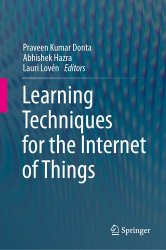Learning Techniques for the Internet of Things
- Добавил: literator
- Дата: 20-02-2024, 20:05
- Комментариев: 0
 Название: Learning Techniques for the Internet of Things
Название: Learning Techniques for the Internet of ThingsАвтор: Praveen Kumar Donta, Abhishek Hazra, Lauri Loven
Издательство: Springer
Год: 2024
Страниц: 334
Язык: английский
Формат: pdf (true), epub
Размер: 31.7 MB
Learning for the Internet of Things is a combination of advanced learning techniques for the Internet of Things (IoT) encompassing a range of cutting-edge approaches, including Deep Learning with CNNs, RNNs, and transformers, Federated Learning, edge AI for local data processing, reinforcement learning for autonomous decision-making, and their applications in real time.
The book is structured into thirteen chapters; each comes with its own dedicated contributions and future research directions. Chapter 1 introduces IoT and the use of Edge computing, particularly cloud computing, and mobile edge computing. This chapter also mentions the use of edge computing in various real-time applications such as healthcare, manufacturing, agriculture, and transportation. Chapter 2 motivates mathematical modeling for Federated Learning systems with respect to IoT and its applications. Further Chapter 3 extends the discussion of Federated Learning for IoT, which has emerged as a privacy-preserving distributed Machine Learning approach.
...
Chapter 10 summarizes the applications of Deep Learning models in various IoT fields. This chapter also presents an in-depth study of these techniques to examine new horizons of applications of Deep Learning models in different areas of IoT. Chapter 11 explores the integration of Quantum Key Distribution (QKD) into IoT systems. It delves into the potential benefits, challenges, and practical considerations of incorporating QKD into IoT networks. In Chap. 12, a comprehensive overview regarding the current state of quantum IoT in the context of smart healthcare is presented, along with its applications, benefits, challenges, and prospects for the future. Chapter 13 proposes a blockchain-based architecture for securing and managing IoT data in intelligent transport systems, offering advantages like immutability, decentralization, and enhanced security.
The book is suitable for a wide range of disciplines, including Computer Science, Artificial Intelligence, Mechanical or Automation, Robotics, and so on. This book’s primary audience is Bachelor’s or Master’s level students. It may be appropriate to consider this book for courses to motivate students in these areas since multiple subdomains/branches are being opened up by many universities. The book provides simplified approaches and real-time applications, so readers without background knowledge of Artificial Intelligence or the Internet of Things can easily understand them.
Скачать Learning Techniques for the Internet of Things
[related-news] [/related-news]
Внимание
Уважаемый посетитель, Вы зашли на сайт как незарегистрированный пользователь.
Мы рекомендуем Вам зарегистрироваться либо войти на сайт под своим именем.
Уважаемый посетитель, Вы зашли на сайт как незарегистрированный пользователь.
Мы рекомендуем Вам зарегистрироваться либо войти на сайт под своим именем.
